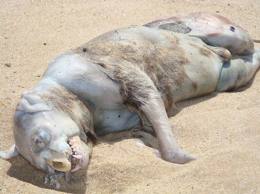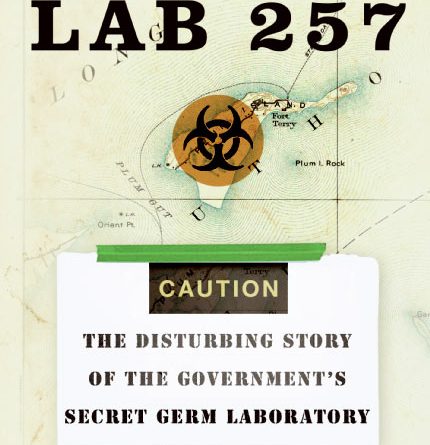Government’s Secret Lab 257 – Horrific Secrets of Plum Island
Source : http://en.wikipedia.org/wiki/Plum_Island_Animal_Disease_Center
Lurking in the dark waters of Long Island Sound is a mysterious place known as Plum Island. Just ten miles off the coast of Connecticut, this tiny speck of land has long been rumored to be the epicenter of top-secret biowarfare research. The U.S. government acknowledges that the island is home to a scientific facility. Its stated purpose is to study animal-borne diseases. But investigators are beginning to uncover startling new facts about this forbidding place. Insiders and ex-employees have come forward to tell their stories. From security breaches in germ labs, to escaped diseases and potential mass epidemics, this is the real Plum Island story. But the government denies anything is wrong.
Plum Island’s Secret Past
Although the origins of Plum Island are shrouded in secrecy, investigations have revealed the startling fact that, in the 1950s, the lab was run by a German scientist named Erich Traub, who was brought to America after the Second World War. His specialty in the Third Reich was virus and vaccine research. Along with rocket scientists like Werner von Braun, Traub was spirited out of post-war Germany to help jump-start the Cold War against the Soviet Union. The well-documented U.S. government project to recruit German scientists and technicians was known as Operation Paperclip. President Truman approved the project, so long as only nominal Nazi party members without SS affiliation were recruited. However, because the Nazi party promoted so many of its top scientists, Operation Paperclip ended up white-washing the pasts of many of its recruits in order to get them into the U.S.
Traub’s particular expertise was in disease-carrying insectsin particular, the common tick. Ticks are often carried aloft by birds, and can therefore quickly spread over large swaths of territory. Called “vectors,” ticks and mosquitoes are also genetically similar. Both contain bacteriophages or plasmids that transfer genetic material into a cell, or from one bacterium to another. In other words, they can infect whatever host animal with which they come in contact. Multiply this by millions, and ticks become the perfect insect army.

On July 12, 2008, a creature dubbed the Montauk Monster washed ashore at Ditch Plains Beach near the business district of Montauk, New York. The creature, a quadruped of indeterminate size, was dead when discovered, and was assumed by some to have come from Plum Island due to the currents and proximity to the mainland. Palaeozoologist Darren Naish studied the photograph and concluded from visible dentition and the front paws that the creature may have been a raccoon. This was also the opinion of Larry Penny, the East Hampton Natural Resources Director,though others claim that this is unlikely and interpret the fleshless part of the upper jaw, visible in the photo, as a beak, implying that the creature was a kind of hybrid monster.
The testing facility at Plum Island is the subject of a novel, The Poison Plum, by author Les Roberts.
The center was also mentioned in the movie Silence of the Lambs by FBI agents who offer Dr. Hannibal Lecter a transfer to it in exchange for his help locating a serial killer. Lecter reads over a report on the location, sarcastically saying, “Plum Island Animal Disease Research Center…sounds charming”, then, rejecting the offer, Lecter refers to Plum Island as “Anthrax Island.”
When Pakistani neuroscientist Aafia Siddiqui, a suspected al-Qaeda member, was arrested in Afghanistan in July 2008, she had in her handbag handwritten notes referring to a “mass casualty attack” that listed various U.S. locations, including the Plum Island Animal Disease Center. In February 2010, she was convicted of assault with a deadly weapon and attempting to kill U.S. soldiers and FBI agents who were seeking to interrogate her.
The Lyme Disease Connection
Traub regularly experimented with injecting dangerous pathogens into insects. The Joint Chiefs of Staff authorized this and similar research in 1952. Dusty files labeled “Tick Research” in the National Archives revealed this quote:
“Vigorous, well-planned, large-scale [biological warfare] test, with results to the secretary of defense. Steps should be taken to make certain adequate facilities are available, including those at Fort Detrick, Dugway Proving Ground, Fort Terry (Plum Island) and an island field testing area.”
In November 1957, the Joint Chiefs also advised that “‘research on anti-animal agent-munition combinations should continue, as well as field testing of anti-food agent munition combinations'”
In the mid-1970s, a mysterious disease broke out in the area around the town of Old Lyme, CT. This severely debilitating syndrome was given the name Lyme disease. At first, doctors were mystified as to why the disease was clustered around this particular town. To this day, some medical authorities question whether the disease isn’t partly psychosomatic.But its victims know differently.
Lyme disease is marked by powerful fatigue, muscle aches, inability to focus and, in some cases, almost total incapacity. After cases mushroomed throughout the Northeast, it was finally investigated seriously. Health researchers determined that Lyme disease had only one cause: deer ticks.
In the 80s, scientists were able to isolate the infectious bacteria carried by the ticks. It was named Borellia burgdorferi, after the Austrian biochemist who made the initial breakthrough. Modern gene-sequencing techniques cracked the code of borellia; in fact, it was only the third microbial gene ever sequenced (after influenza and a rare form of genital herpes). When the data came in, it rocked the scientific world.

This leads us back to Erich Traub, the German scientist who participated in research at Plum Island.
Once they had the genetic footprint of the Lyme disease germ, researchers began to comb through disease cluster histories. It didn’t make sense that Lyme would suddenly emerge, seemingly out of nowhere, in one town in rural Connecticut. Some of these investigators believe they found traces of borrelia in preserved insect and animal samples taken from nearby Shelter Island, as well as Long Island. The samples dated from the late 1940s to the early 1950sthe timeframe in which Erich Traub was infecting ticks on Plum Island.
Building 257’s Super Secret Research
A local television reporter named Karl Grossman took up the cause of Lyme disease victims. He discovered that more than 140 species of birds frequent and nest on Plum Island. Suspicion then fell heavily on one particular building on the islandthe ominous and supposedly super-secure Building 257.
A maintenance worker on the island named James McKoy repeatedly complained about shoddy security at Building 257and was summarily fired for his trouble. Tom Ridge, then head of Homeland Security, the agency ultimately responsible for operations at Plum Island, refused to comment on the firing even when the firing was personally questioned by Senator Clinton. McKoy told an alarming tale about a cold December day in 2002. The power in the labs failed, and the emergency generators were unable to pick up the load. For four hours, workers were frantically trying to seal the doors of Building 257 with duct tape, which is good for a lot of things, but not stopping microscopic particles.
And there are other stories like Jim McKoy’s.
But something happened that was even more bizarre.
Monsters and Mutants
Drawing of human body with elongated fingers
that washed up on Long Island (truTV)One sunny day in the summer of 2008, vacationers in Montauk, Long Island, ran screaming from the beach. Something unspeakable had washed ashore. At first glance, it appeared to be the carcass of large animalbut what kind? The dead beast emitted a sickening odor. Bloated and leathery, it had patches of coarse hair spread unevenly across its body. With its hideous elongated, almost dinosaur-like skull, and odd matchstick-shaped fingers, it looked like nothing anyone had ever seen before.
The beach where the monster was found is just 10 miles from Plum Island.
Local officials offered no explanation. Socialites in the ritzy Hamptons were thrown into a panic. Speculation immediately mounted that the creature was the result of an animal experiment gone horribly wrong. Official denials were quick to come from Plum Island, which was now operated by the Department of Homeland Security. But this monster wasn’t the only one.
In spring of 2009, a second hideous corpse came ashore at Montauk. This one was almost identicalsame elongated skull, same weird claw-like fingers. Once again, local officials had no explanation. The carcass was quickly spirited away and, to anyone’s knowledge, was never examined by an independent zoologist.
And just when you think the story couldn’t get freakier, it did.
Police were called to Plum Island in January, 2010. A human bodya mutated human bodyhad been found by workers on the island. The official police report described “very elongated fingers.” The body had no identification. Moreover, five symmetrical holes had been drilled into its skull. At first, Suffolk County police said it was the body of a white man.
A day later, they changed their story and claimed it was a black man. To date, they have offered no explanation for the two conflicting reports, except to say it was an “oversight.”
Mutated corpses, hideous monsters, terrifying germ leaks, secret experiments? Could the stories about Plum Island get any more frightening? What if they moved this dangerous research to the middle of America’s breadbasket?



